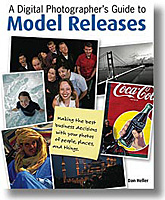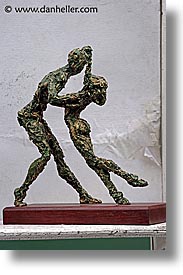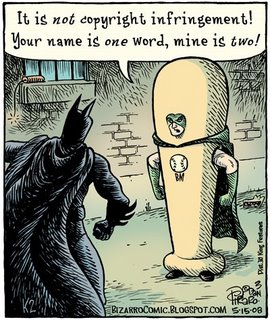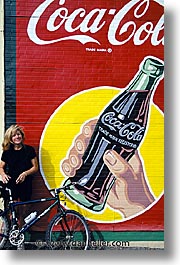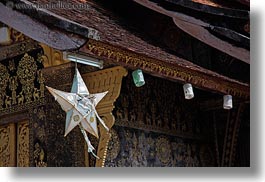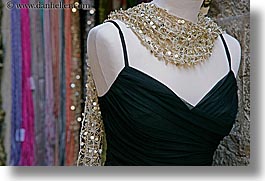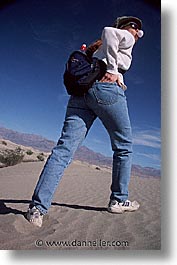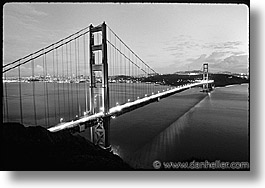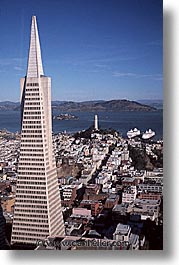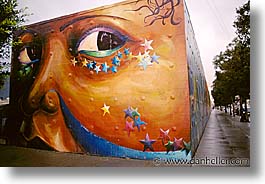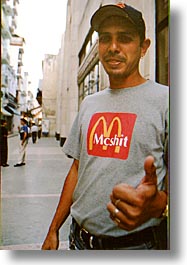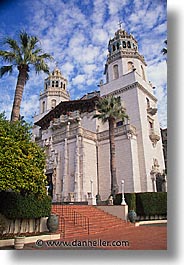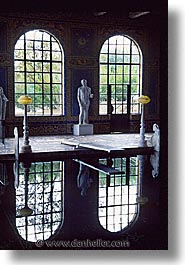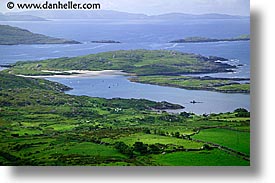|
Markers indicate locations for photos on this page.
Accuracy responsibility of Google Maps
Google Map Goes Here
If you see this text, the map is still loading (or there's an error). |
Most people who read this page for the first time are looking to find whether they need a release for:
If that's what you're wondering, understand that the need for a "property release" is not triggered by the subject of the photo. It depends entirely on how the photo is published. In other words, a release is only necessary if the manner in which a photo is presented implies an "association" between the photo subject (person or thing) and the publisher. That is, the person or company that is responsible for putting the image into public view. That entire paragraph is the entirety of the discussion, but as you can see by the length of this article, there's a lot of detail. Let's begin with the basics: Photographers can take pictures of anything they want—people, buildings, works of art, anything—without requesting permission of anyone. Taking pictures is not the same as publishing them. What's more, you can always sell pictures... of anything. Selling pictures does not require permission (like a property release). A release of any kind is only required if the photo makes it appear that the subject of the photo advocates a particular point of view (supporting a product, idea, ideology, relgious or political position). Simply put, you can't publish an image in a way that makes a person appear that they support something without their permission. If the photo would imply that association, then the entity that publishes the photo—which usually isn't the photographer—is responsible for getting permission from that person. Just because a photographer takes a picture does not create that association. And just because a photographer sells that picture to someone else (such as the publisher) does not create that association. The act of selling a photo is merely a financial transactional, which doesn't imply "association" at all. More information about this can be found in Model Release Primer. Because there's no association, photographers often ask, "So, then why do photographers need releases?" The answer is they don't. Only the publishers need them, and those are rarely the photographers. They only get those releases to make it easier to sell the photos to the publishers. Get it yet?
Perhaps not. But that's why you're here.
The root of all the misinformation about property releases stems from a simple misunderstanding: They think that because people own property, they therefore have a right to say whether photos of their property can be published. And that's entirely false. In fact, it may shock you to hear it, but there is no such thing as a "property release." Let me be more precise—most conventional "property releases" have no legallly binding basis in law. Yes, there are ways to protect "property," but it's limited to "intellectual property," such as creative works—art, music, designs, or any other human-created work, not based on science or nature. This is called "intellectual property," and that kind of property is protected by copyright and trademark registration. Nature cannot be copyrighted, which means one cannot copyright their land or their animals. While buildings and other manmade objects can be copyrighted, it's not that simple either—the copyright and trademark protections only apply if the photo of the article could imply an association with the publisher. In other words, publishing a photo of someone's building doesn't imply anything by itself. That is, no one is going to assume the building is owned by the photographer or the publisher of the book or website where the photo appears. There would have to be text that makes this association. For example, text would have to say, "This is my building design." Now THAT would require permission from the designer, if it wasn't you. And as you know, that never happens, which is why a bona fide property release is rarely ever needed. And that brings us full circle. So, the easy way to think of this stuff is this simple process:
If you can make it through each of those tests all the way to the last one, you've got a rare set of circumstances. And, as I'll discuss later, if these tests ultimately trigger the need for a release, it will almost be guaranteed that you are not going to get that release; the licensee (user, publisher) of the photo will. This is for the sole reason that if the release was even needed at all, the owner of the trademark will likely demand a direct relationship with whoever's going to use the photo, and also charge lots of money for it. Ironically, an easy test to determine if a release is necessary is to simply ask for one from the property owner. If they sign one, it's almost assured that one isn't necessary at all. Another way to look at it is this: Money's role in this is a direct relationship to the value of the property as a recognizable commodity. If someone is willing to sign a property release without any (or a small sum) of money, then the release would not be required anyway, because the only reason for a release is to protect and enhance the monetary value of the property. If it has no value, no release is required because there's no inherent value of the property to protect. If it has value and if the use of a photo of it would imply an association with the publisher, then the value of the property release would be high—considerably higher than what an individual photographer would pay.
Everything stated above is basically all you need to know. However, upon
first reading, most people are just scratching their heads. But, I assure
you that once you finally "get it", you'll be able to reread that entire
introduction and it'll make sense.
But let's say that the gallery that sells the statue uses that photo to promote the artist. Some might argue that the artist's work being featured in an ad would help sell his work, so why would a release be required? Well, a poorly shot photo (composition, light, exposure) could potentially harm sales. Because the artist owns the copyright, it's up to him (no one else) to decide whether the photo in question can be used for this promotional purpose. So the gallery can't use just any picture it wants—it has to use the photo that the artist grants permission to use. (Because of that, many galleries have contracts with artists that require the artist to grant permission to the gallery to use any photo the gallery wants, specifically to avoid this possible conflict.) By contrast, a newspaper article (or blog entry) that comments on the work does not need a release to accompany the photo because the use of image is for editorial purposes. This is defined by the "fair use" provisions of Copyright Law. These two examples are very common and simple cases, but one that quickly and simply summarizes the basic principles involved here. Perhaps one might have guessed the newspaper example easily, but perhaps not the gallery example, especially since the artist already has an existing business relationship with the gallery. These kinds of scenarios are often overlooked because such relationships rarely have conflict over the use of an image. That is, an artist wouldn't object to a gallery using an image of his work for the originally speculated reason that it's generally in the best interests of the artist to have the photo used. It's also highly unlikely that a "bad" photo would be used, because it's in no one's best interests to do that. Furthermore, it's often the case that the artist is the one who has photos of his own work shot, and he provides them to the gallery for exactly these uses. So, no one ever thinks to ask whether a release is required, nor do people actually get releases for cases like this. In fact, virtually all such uses of copyrighted items are similar in that the use in question doesn't actually harm anyone, and because there's no conflict, it doesn't actually matter. And it is for all these reasons that the "de facto" behaviors are assumed to be what is legally permissible, feeding the gross misperception of what is really involved in copyright law regarding photography. Just because people's understandings are wrong doesn't necessarily mean bad things will happen. Business is all about relationships, and, as most lawyers will tell you, relationships have a tendency to break down when disagreements arise. And when that happens, it's best to have your agreement in writing. On the other hand, it's not always easy to anticipate future disputes and document conditions in an agreement. By the time the dispute comes up, if the written agreement doesn't anticipate those conditions, now it's an argument up for a judge or arbitrator to decide, and the winner goes to the side that knows how to argue better. Note, I did not say to the "correct" side. Suffice to say that if there's a dispute, it's most likely not that black and white for a third party to easily point to a winner. Both sides have to present their case, and it's usually the case that the side with the best lawyer wins, and that's usually the more financially capable side. The pros and cons of having a legal agreement ahead of time are best weighed by the economic value of the business relationship. It's often better to not muddy the waters on a simple relationship involving a simple transaction that doesn't involve that much money. All too many times have I seen photographers get so wrapped up in the mechanics and details of such trying to be legally "tidy" that they actually harm the relationship or themselves, sometimes even preventing the transaction itself. "Don't spend a dollar to save ten cents." If I had to summarize licensing photos of copyrighted and trademarked works, it would be to understand how an item is used in publicity and the economic ramifications of such use. Even more briefly, who is making or losing money (or opportunity) as a result of the use of the photo? Answering that is not done by looking up legal statutes on the books. It involves considering both sides of an argument, which often results in back-and-forth arguments, "on one hand," and then, "on the other hand." This is what prompted President Harry Truman to once proclaim after a grueling lecture the US economy, "I wish I could find an economist with only one hand."
In that spirit, we're going to be looking at a lot of hands in this
article.
Because of the nature of photography and the business of photographing other works of art, most people become confused from the entanglement of the photo itself and its contents. These two are entirely separate animals; the photographer owns the copyright to the photo, regardless of the subject of the photo. So, while you (as the photographer) may have the right to license the photo to someone (because it is yours), the use of that photo may be restricted because the subject (the statue) is copyrighted by someone else. This is very similar to that of photos of people. If this concept is new to you, read Model Release Primer. The same also goes in reverse: the artist that created the sculpture may permit the use of the photo, but he himself does not have the right to the photo itself (or to use it himself). This, because the photographer owns the copyright to it. If you're confused here, it's because there are two works of art involved: a photo, and a sculpture. The copyright for each is owned by the respective artist, irrespective of he fact that the photo contains of photo of the sculpture.
Ok, at this point, I'd be talking in circles if I were to continue, so
let's move on. This will al become clearer as I illustrate more examples.
So, if all these things are copyrighted works, how can photos of them be sold without objection by the copyright owners? If you're like most people, you'll probably guess that it's because few of the items in the photo are clearly identifiable, similar to how the people in this photo also aren't. Good guess, but unlike with people, identifiability is not really the primary trigger for a release in this case. (It's important, yes, but stay with me here.) Rather, it is the implied association between the copyrighted item and the manner in which it is used that matters most. The reason the photo of the sculpture requires a release by the gallery is because there is a very close association between the two: the gallery and the artist rely on one another to do business, and hence, the photo of the sculpture directly affects the gallery's ability to do business. Photos of clothing that people happen to be wearing—or buildings in a cityscape—don't imply or infer a similarly direct relationship between the copyright holders and the entity that puts the photo into use. (Note once again that the photographer himself has nothing to do with any of this.)
So, the thing to anchor in your mind is that implied association. But
now I want to ratchet it one step further: while there could be
some arguments made between opposing parties on whether there's an
association for a given photo of a copyrighted or trademarked item,
courts like to see just a tad more relevance, and that comes by measuring
whether there is a "material economic impact", positive or negative,
among the parties. In the practical world, almost no photos you see
in everyday situations require releases because this is a high hurdle
to clear, even though the "objects" themselves are clearly identifiable
(and presumably copyrighted). We'll get into more examples of this soon.
Some quick definition: A copyright springs into existence the moment a work is created. Copyright law specifically states, that the work must exist "in a fixed and tangible medium for at least some period of time, no matter how brief." For photography, the work is instantly copyrighted by the photographer when the shutter is released. For an author, it's when he writes his book. For a choreographer, it's the moment he designs a dance step. For a sculptor, it's when he chisels. For an architect, it's when he drafts his designs. For a drunk sitting at a bar scribbling prophetic love notes on a napkin, it's when the pencil (presumably) hits the fabric. Anything that involves an "original" creative process is automatically copyrighted when the creator makes it. (Registering a copyright is an entirely different matter, but a very important one, as discussed at the end.) A trademark springs into existence whenever "it" is used in commerce as a "distinct indicator of a single source of origin or sponsorship," as defined by trademark law. It's beyond a photograph; it's a conceptual element whose representation is identified by the design. It can even be a sound. (Think of the Intel "tune" that's played on TV commercials that sell PCs.) Sounds complicated? Consider the most well-known examples: the Coca Cola logo, the Nike swoosh, or the CNN icon on TV. Each of these are clear identifiers of an origin. Because they are instantly recognized by most people, they carry a great deal of "good will" because the value that products or services receive by being associated with the trademarked item is high. For example, if Nike comes out with a new shoe that dons the company's "swoosh" logo, the general public will probably accept it with less scrutiny (and thus, buy it), simply because of the logo. By contrast, if the exact same shoe came from a generic (unknown) manufacturer, it could sit on the shelf for quite a while without being purchased. In fact, many stores wouldn't even put on the shelf in the first place because of its lack of "goodwill". If Coca Cola comes out with a new drink, and the bottle or can has the Coca Cola logo, chances are higher that stores will carry it and that people will buy it, even before knowing anything about it. Hence, the mere existence of the logo on a product can have enormous economic value if the logo is well known and popular. Now we can differentiate between Trademark and Copyright: the design of the shoe is copyrighted; the use of the logo is trademarked. The copyright prevents someone from copying the shoe's design, and the trademark prevents others from using the logo to promote their own products (or to suggest an affiliation with the real mark's owner).
As a photographer, you're already a little familiar with copyright, because your own photographs are copyrighted by you, which means your financial interests are protected from other people using your photos without your permission. (You grant them permission to use them through a license agreement.) It's the use of your actual image (or a portion of it) that requires permission, not the contents of the image, or even the idea behind it. Even if you are very well-known for a particular image, if someone else took a photo of the same thing, they own the copyright to their image and can license it without compensating you. Even if the photos were shot precisely at the same time, in such close proximity to you, that the photos appear otherwise identical, they can license their version of the image to someone, and you don't receive a license fee. This sort of thing is very common at sporting events, political rallies, or at well-known national landmarks where photographers congregate in close proximity to shoot the same subjects. In summary, only the specific photo you took is copyrighted by you.
While the photo enjoys the protections of copyright, you don't
trademark a photo. The purpose of a trademark is to protect a design
element that you use to represent yourself, such as a logo (which
you use regularly on your stationary, envelopes, website, and so
on). While you can technically use a photo as (or in) your logo,
the trademark is really there to protect the association with you.
Anyone can use your logo without permission, so long as the use isn't
done to represent themselves (stealing the logo), or is not used to
imply an association with you (or the good will of your name), or to
damage your reputation by misrepresentation. That is, by showing a
really bad photo and using your logo on it to fool people into thinking
it's your photo. This is distinct from damaging your reputation by
simply criticizing your work—that's free speech, and people can
use anyone's copyrighted work, or trademarked logo to do that. In fact,
you see it all the time in magazine and newspaper news articles and
art reviews. We'll get into the details of this later.
As discussed above, a trademark implies an association between the user of the photo (publisher, advertiser, etc.) and the owner of the mark. If so, there also has to be a value connected with that association.
It is for these reasons that you see photos with the Coca Cola logo in many places—textbooks, newspapers, here, and even catalogs—and yet, no release is necessary. That isn't to imply that a release is never necessary; there are violations all the time. The point is that a release is not necessary if the use does not meet certain criteria, and that the financial impact is high enough to warrant pursuing through the courts. If you have a photo that happens to include the Coca Cola logo, (or any trademarked item), the question as to whether a release is required has nothing to do with your having the image, nor your ability to license the image; but rather, how the person who buys the image puts it into use. If that use implies an association, or relies upon the good will of the logo, then a release may be required or desired. But that decision is made by the licensee, not the photographer. Now, as a business person, you want to optimize your ability to license whatever images you have. And, as discussed in the chapter on model releases, you can increase your potential revenue for licensing a photo into the commercial market if you have a release ahead of time, thereby making it easier for the licensee. After all if they're protected ahead of time, and it's easier for them, the quicker the sale to you, right?
Nice idea, but there are three problems. First, asking a well-known
company to sign a general release for a photo of their logo (without
a specific use in mind) in anticipation of some as-yet unknown
license, would be like asking a well-known celebrity to sign an
open-ended model release—they're just not going to do it. Second, the
opportunities to license such photos for these kinds of commercial
uses are so exceedingly rare, that it doesn't really make business
sense to spend the time and energy trying to get pre-signed releases
of copyrighted or trademarked items. And third, anyone that actually
would require a release for using a photo that happens to contain
a logo is going to go directly to the source and get their own permit
anyway. Their lawyers won't want to depend on trusting an unknown
third-party, such as you, for a model release. the liability is too high.
All this explains why don't I include samples of releases for copyrighted or trademarked items, like property releases. Those that are actually used in the real world are very specific about the use, are long and detailed in legalese, and are often the result of both parties' lawyers having gone back and forth many times. That's not to say that boiler-plate property releases don't exist. They do, and a search on the net yields many results. Yet, the catch-22 is that almost all the conditions under which these so-called releases would be used are simplistic cases that wouldn't require releases anyway. If a release were necessary, these template agreements would be far from useful. And again, because photographers aren't the ones that need these kinds of releases, their usefulness is next to nil. Such releases are needed by whoever puts the image into use, so let their lawyers take care of it. In short, almost all property releases are merely placebos. This presents one last dilemma for which I have no great advice: what do you do about people who think they need a release for a photo, but actually don't? This reminds me of the Monty Python skit where a man goes to a government office and asks to buy a license for his pet fish, Eric. The clerk tries in vain to tell the man that he doesn't need a license for a pet fish. The man insists that a fish license is required, and proves it by producing his official 'cat' license. The clerk reads it and responds, "that's a dog license with the word 'dog' crossed out and the word 'cat' written in in crayon."
In cases where you're dealing with clients that don't know what they're
talking about, you're left to your own ingenuity on how to handle it.
The worst thing you can do is attempt to pacify the client by producing
a phony license, only because this would constitute fraud. And the
second worst thing you can do is actually attempt to get a release
(especially using one of those boiler-plate forms found in books or on
the internet) from a trademark or copyright holder to permit the
photo to be used in a manner that doesn't require it. This would paramount
to opening Pandora's Box, involving lawyers, time, potential (and
unnecessary) fees, and of course, paperwork. (Of course, you could
just tell your client to buy my book and
have him read this chapter!)
The key theme to everything discussed above is "commercial uses," which are actually less common as a ratio of all photos licensed than people think for photos of such items. Given this, you might already be feeling safe. Now, I'd like to actually lull you into a deeper slumber of complacency with this: There was a case in Ohio involving a photographer who sold posters of a photo he took of the Rock and Roll Hall of Fame in Cleveland. (Note: this is one of those rare cases where a photographer also happens to be the publisher—he's putting his own photo "into use.") The building's design is rather unique, and the owners of the museum had it trademarked. So, they sued the photographer for infringement, and they won. Yet, a federal court of appeals reversed the decision, and permitted the use and sale of the photographer's posters. From the court transcripts, the judges in the majority opinion wrote:
So, now that you've been lulled into complacency, here's the reality jolt: the court ruling was a 5-4 decision, a razor-thin margin that should not be relied upon as a sweeping precedent. The opinions of the dissenting judges were more along the lines that most people expected: that the sales of the posters were benefiting from the "good will" of the existing landmark, which is supposed to be protected by trademark. It just so happened that the trademark owners were just a little too "loose" with how they represented their mark, which caused the court to tilt in this particular ruling. As a result, photo discussion groups on the internet were abuzz with statements from photographers about selling photos of other famously trademarked buildings. But, this is a naive business decision, as circumstances could have easily gone the other way. The case is Rock and Roll Hall of Fame v. Gentile 134 F.3d 749 (6th Cir. 1998), and makes for interesting reading for a variety of reasons that the truly dedicated reader may enjoy delving into.
Granted, the actual details of such "trademark clashes" get more involved than this, but the point is that courts regard trademark infringement with a keen eye on precedent (how long a mark has been in use), intent by both parties, and by the public's perception of identity. They want to leave well enough alone if they can.
A mark can even lose its protections if it enters into the public
domain due to common use in the vernacular. For example, "google"
is having a hard time keeping the word "google" from becoming a
generic synonym for "search," since it's becoming common for people
to say "you can google it" when they mean to search for it on the
internet. Such uses dilute the company's ability to protect the
mark in some contexts, since "common vernacular" implies the loss
of "the distinct commercial impression as an indicator of a single
source of origin or sponsorship."
Another byproduct of "scope of use" is that one can't register a mark (and benefit from protections) unless it is used in commerce. Here, "commerce" is not the same as "commercial use." It just means that the mark has to be used in the normal course of business. Even companies that engage in non-profit or editorial businesses are considered to be using their logos in "commerce" because they buy and sell things, they pay people, and they have an identity. Simply put: if you touch money, you're engaged in commerce.
Why is this important? First, a mark has no protection if it's not used. If someone brings a claim against someone for using their trademark, but they never actually put it into use, they have a big steep uphill battle to fight. For, not only do they have to prove that it was in use, but there is "value" in the mark. While there is a nominal statutory fine for violating a trademark that has no value, this is hardly worth paying the court fees to pursue. For there to be substantial monetary recovery, the mark has to have generated good will. If the mark is unused, it is unknown to the public, so it has no value.
Again, how does this relate to you, a photographer? Because among
the most commonly misunderstood aspects of licensing photos is that
of licensing photos of buildings. That is, the enigmatic "property
release." So, let's get into that next.
The source of this misunderstanding is the copyright: buildings are made from architectural designs, and such designs are copyrighted by definition, exactly the same way photos are. Also like photos, architectural drawings don't have to necessarily be registered to be protected. So, technically, items such as buildings are protected by copyright protection, as any other item would be. The part that's misunderstood, is that "any" use of a photo of a copyrighted item does not itself constitute a violation of that copyright. The protections that copyrights provide usually come down to some economic measurement: is the display of a photo somehow having an economic effect on the copyright owner's ability to sell his product? Does it diminish its value? Similarly, is the use of the photo somehow enabling the user to benefit economically? That is, just as the "good will" of a well-recognized logo may help with the perceived value of a product that bears it, a "good design" (regardless of whether it's recognized) can have a positive economic effect on the user's ability to sell his wares. The question of whether any given use violates a copyright is judged on how closely one can attribute the use of the photo of the item in question with any of the hypothetical effects listed above. Think of the example I used earlier of the photo of laundry hanging from clothes lines. Let's say a travel agency wanted to license this photo for use in an ad for travel to Venice. Yes, clothes are copyrighted by their designers, but there's nothing unique about the specific designs of these particular clothing items themselves that aided in someone's desire to travel to Venice. Nor could one argue that the photo is harming the sale of these particular clothes manufacturers. In fact, even if the ad were used by makers of a laundry detergent, it wouldn't matter. In fact, the ad could be for another clothing manufacturer, and it still wouldn't matter, because there's simply not enough connection made between the articles themselves and their copyright holders. Thus, if such a photo were used in any ad—regardless of its nature—no release would be necessary from whoever owns the copyright to those designs.
Broadening the scope wider, consider a travel agency that wanted to license the same image to use in an ad for trips to Dubrovnik, Croatia (where the photo was taken). This is a much broader distribution of publicity, and the target audience (luxury travelers) may be more interested in the destination because of a perception of fashion sense. Is that a kind of use that would require a release for these copyrighted items? What's your call? Enter the multi-handed economist (or lawyer). On one hand, it could be argued that the jewelry and clothing in this photo have nothing to do with travel, and that the cross-over between those who read a travel magazine and those shopping for attire are insufficient to cause harm to the clothier's sales. Nor would it be easy to demonstrate that travel to Croatia benefited directly from the use of this photo. On the other hand, we don't really know a whole lot about the items in the photo, and whether they are representative products from that region. If the scarf was really a jewel-encrusted elaborate necklace made by a well-known designer, like David Yurman, then chances are someone's going to get a call from a lawyer. On still yet another hand, for all we know, the scarf was made in Slovenia, and the jeweler was Slovenian, and he happened to have just moved there. (Why not? I've seen Chinese Restaurants in every country I've ever traveled to.) There are so many things we don't know, that the pendulum could swing in all directions.
As for the protections offered by trademarks, the association with tourism here is not one that implies "sponsorship" by the makers of the jeans. Even if they were Levi's brand, one cannot see it from this photo itself, so there's no association. (Here's a case where identifiability is important.) If there were a clearly identifying feature that would cause a reasonable person to draw such an association, then a release may be required, but it's not yet definitive. Why? Because Levi's has become a very common, almost "generic" American look; a photo of someone wearing such pants is so common, that it is not necessarily itself a form of sponsorship. How large would the Levi's logo have to be to suddenly trigger a perception of co-branding, or that one could attribute the theme park as exploiting the good will of the brand to attract visitors? There is no answer, and even assessing the "risk" itself is unscientific. Because of this unknown, the one who chooses to assume the risk is the licensee of the photo. They alone assume all the risk, further underscoring why no one except for the licensee needs to worry about it. For if it were otherwise, then photographers would be bearing the responsibility for all photos published, and publishers wouldn't care at all. This should help make the discussion on the use of photos of buildings much easier, if not obvious, at this point. The mere portrayal of a photo of a building in an ad or other commercial publication is insufficient to say a release is required. It's the context for how the property is displayed that matters, and the associations implied, and their potential economic effects. Copyrights cover the physical object itself from being copied, its design from being stolen to make duplicates, and from others exploiting its uniqueness for financial gain. For a violation to occur, the owner would have to convince a judge of these facts.
And this brings us right back to where it started: the copyrights
for a building have its limitations, but then, so do trademarks.
For them to have value, the mark's "good will" and the "perception
of association" must be shown. Most buildings are either not
trademarked, or even if they are, have minimal "good will" value.
Of those that do have value, the use of the photo has to suggest
an association with the mark, or impugn upon its value in some way
that isn't protected by free speech. The general rule of thumb is
that the cases where a property release is required are so minimal,
you can consider it more the exception than the rule. What's more,
those exceptions will be pretty obvious when they do occur.
Let's consider the use of a photo of a building in an ad promoting tourism to a particular city. Is this a commercial use of a photo? Is "commercial use" sufficient? What's the association? Is the city implying an association to the building (or with its owners) so as to attract tourists? Does the use in question harm the good will of the mark by diluting its perceived value? Remember to avoid mixing your notions of trademarks and copyrights. To answer that question, we need to take a side step and discern a little more carefully where trademark and copyrights differ. Since this confusion comes up so much, let's see if an example exists where there's a building that's both copyrighted and trademarked, and understand the ramifications of each as it applies to our hypothetical question.
Turns out, the Golden Gate Bridge is trademarked, but the use of the mark is so copiously visible in all manner of media, that the risk of violating the mark through the proposed use (advertising tourism to San Francisco) is nil. (Again, see the point made about "generic use.") This doesn't mean that the mark has lost its protection, it just means that the scope in which the bridge chooses to enforce its protections is limited (and that limitation does not include the hypothetical use posed above). It also helps that the owner of the trademark is a government institution, and their main goal is to prevent misrepresentations of the mark, or other dilutive effects of the mark's good will. As such, you rarely see scary or harmful images of the bridge, such as it blowing up in movies. You also don't see other products and services not related to the bridge. But, you will see many uses of the mark on advertising materials promoting tourism in San Francisco. So, the city of San Francisco (or anyone, for that matter) can use photos of the bridge to their heart's desire.
Here, the building's owners hold both a copyright and a trademark registration. In the case of the copyright, no similar buildings could be erected based on that design (at least, not without permission). As for the trademark, the design of the building is also represented as a "logo" with a similar shape, and it is used to represent the company and its various business units.
On the other hand, I can freely use the Transamerica logo in this
text to discuss the topic because I am not using it as a source of
"good will," exactly as discussed in the case of Coca Cola. Whether
I (or the publisher) "make money" from this text is irrelevant, and
whether you read it for free on the web, or pay for a book with
this text are also irrelevant. It's only how the mark is represented
in the work that matters.
At this point, let's sum up what we've covered so far:
Got all that? Good. We just covered the hard stuff. Hard, because
commercial uses of photos of trademarked and copyrighted things
can be complex, not because you are really at any higher risk (nor
are your clients who license photos). The reality is that commercial
uses of photos of trademarked items are rare, and almost always
handled separately by those who license them.
Now that we've covered commercial uses, let's get to the fun and easy stuff: editorial uses of copyrighted and trademarked items. One of the key foundations for why editorial uses of trademarked items and copyrighted works do not require releases is described by a principle known as fair use. Here is an excellent excerpt from Stanford University's website on copyright and fair use: (http://fairuse.stanford.edu/Copyright_and_Fair_Use_Overview/chapter9/index.html): Fair use is a copyright principle based on the belief that the public is entitled to freely use portions of copyrighted materials for purposes of commentary and criticism. For example, if you wish to criticize a novelist, you should have the freedom to quote a portion of the novelist's work without asking permission. Absent this freedom, copyright owners could stifle any negative comments about their work.
Another example of Fair Use can be found a term called, Found Art. This refers to the use of an object that, because of its very nature, evokes social commentary. Here, a copyrighted or trademarked item can be displayed (and sold) as artwork, overriding its usual protections. The most common example of this in today's society is "mash-ups." We see this on websites where people combine various parts of other people's photos to create new ones. This is perfectly legal under "fair use" and no releases or permissions are necessary, irrespective of the copyright status of the work, or the wishes of the artist. An example that includes a trademark might be the use of a photo of an old "Sambo's Restaurant." Up till 1978, Sambo's was a chain of pancake restaurants based on the famous story of an encounter between a little black boy named Sambo and the tigers. The restaurant was forced to close its doors on due to the then-derogatory use of the name "Sambo" referring to black people. At the time, it was a heated and highly emotional battle. Using imagery of the restaurant today for the purpose of depicting how social change has taken place within society may be regarded as an example of "found art." It will still, no doubt, evoke strong emotions among viewers, especially those who "don't get it." This, ironically, is part of the purpose of artwork: to evoke such discourse. This artistic use of trademarked material without prior permission from the owner is protected under the First Amendment.
As for "artistic photos" of trademarked items, there's the case of
Mattel, Inc. et al. v. Walking Mt. Productions, which you can read about
here.
Mattel sued an artist and his company for copyright and trademark
infringement based on the artist's use of BARBIE dolls in a series of
photographs depicting them in various unflattering poses, and use of the
BARBIE mark in connection with the photo series. The court found that
the photos are permitted under "fair use" professions, which precludes
Plaintiff's trade claims. Furthermore, the artist may sell postcards
featuring the same photos displayed in the exhibit, since an artist
is permitted to sell his own artwork in other formats. In the court's
opinion, the average person would not necessarily assume that the
Mattel company was an advocate or sponsor for the photos depicted.
This then raises the question of whether the piece is satire. As you probably know, what may seem funny to you and me is often not funny to the target of the humor. If a statement sounds like an accusation of a serious nature, but the intent was satire, there could a court battle to determine which was the case. To quickly test if you've been paying attention: let's say the TV show was found liable for making defamatory statements about the celebrity (or trademarked item), how does that affect you? Are you somehow wrapped up in this because you're the one that licensed the photo to the TV show? For answers, see Model Release Primer.
One twist on satire is the extent of which it extends into commercial
ventures. In other words, to what extent is the trademark being
capitalized upon to leverage the sales of a new product? If someone were
to make a t-shirt the satirized a particular and well-known American
hamburger restaurant chain, this is clearly satire, and is protected.
However, if one were to mass-produce the shirts, could it be considered a
violation of the mark? You should be able to answer this one too,
as pointed out before: the act of making money has no bearing on whether
a mark has been violated.
The pragmatic reality of the world is that the law doesn't necessarily govern what really happens. I remind the reader that anything still can provoke the swift and full attention of plaintiffs and their lawyers, who may choose to file a suit, even if they are wrong. Some people are so overly aggressive in protecting their trademarks because they don't even want people to think poorly about them and stain their reputation. It is often the case that unwarranted trademark violation suits are filed for the sole purpose of stifling undesirable statements about a company or its products. So, don't necessarily believe that if a company takes some form of legal action, or sends intimidating letters, that they are "right." More often than not, they are just posturing.
For example, an article in the New York Times on August 2, 2007 titled,
Content Makers Are Accused of Exaggerating Copyright,
companies from all around the media dial were accused of misleading and
threatening consumers with overstated copyright warnings. The article
cited one example, "photocopying a page from a book to use in class,"
which is perfectly legal, as are many other uses, including making copies
of all matter of content for personal use.
At first, I was honored, and felt that it was a great opportunity for me. But, when I got their license agreement, I noticed that the indemnification clause was very specific and overly protective of themselves. Normally, indemnification clauses simply assure that the photographer is the one who took the picture and has the right to license the image, but this clause went far into very detailed descriptions. It made it clear that I understood that they were going to use the image beyond editorial use, and that I would "hold harmless any claims that (Hearst Castle) would make against (the magazine)", for just about any reason at all. This kind of language was so far beyond the normal verbiage customary in indemnity clauses, that it prompted me to ask about it. I was told it was just a "boiler plate" agreement, which, as all photographers know, is a common response to just about any objection one might raise. Accordingly, my usual response is to probe and pry and negotiate out of it. But, there was no negotiation on this point whatsoever. Their intended use of the image was indeed beyond just editorial as they said. In fact, the magazine wanted the right to use the image in CDs, products of many sorts, and extended uses beyond description. This is where several things dawned on me that raised suspicion:
By now, I put all the pieces together: the magazine wanted to license the image from me because they knew they couldn't get it from any other source. Then, they were going to have me sign an indemnity clause to protect them against the suit that the Castle was assuredly going to brings against them for their use of the image in commercial products. I called a lawyer and asked two questions: First, is the magazine truly protected? That is, can the Castle make claims against the magazine, or is it all directed towards me? Despite the appearance that I bore responsibility because of the indemnity clause, it isn't that simple. First, there's the elephant in the middle of the room: the magazine's large size and deep pockets would be the more realistic target for the litigants. Second, even if the magazine tried to exercise the indemnity clause, there's a term in legal circles called, "Unclean Hands Doctrine," which states that if someone does something that's within the letter of the law, but is clearly acting in bad faith or in an unethical manner. This is often why indemnity clauses are hardly ever enforced. You aren't going to be responsible for the bad act of someone else's deeds if it's clear what their strategy and motivation was. In this case, the magazine would re-inherit the responsibility again. Ironically, now that I knew what was going on, I realize that I, myself, was part and parcel to the mischief.
The next question was about the contract that was on the ticket. This isn't so straightforward. It was this lawyer's opinion that such contracts are, in fact, enforceable, but the circumstances are rather involved. Turns out, this is more about contract law than it is about trademark law, so it was outside of his field of expertise. I've spoken with other lawyers about it, and have had mixed responses. One comment stuck with me from one lawyer was this: "The part that usually trumps the issue is the fact that many of these tickets are used for private property, and the Hearst Castle is sort of a hybrid of both." Then there's the case of the San Diego Zoo, which is a privately held company, who has copyrighted and trademarked their logos and other artifacts of the property. They also happen to be known for pursuing photographers for copyright violation, as evidenced by searching for relevant search terms on most pro photographer internet forums. The zoo's basis for their legal argument is the same as the Hearst Castle's: The ticket is a contract that says you can't take photos for commercial use. And this raises two issues: intent and the definition of "commercial use." Technically, the contract is intended to prohibit commercial photographers from coming into the park with the intention of shooting pictures that would be used for commercial purposes. This might include simply shooting a model standing next to an elephant. Here, this is a matter of private property enforcement, and this act can be prevented without having it in the ticket contract. So, now the question is whether someone (say, a tourist) shoots a lot of family photos, and years later, someone asks them to use the photo for an ad of some kind. In this case, there was no initial intent to sell the photo, so now it's a question of whether this contract can prohibit the tourist from selling the picture. As another lawyer put it, "While the zoo may prevent you from taking pictures while on their property, once you leave, your photos are yours, and the only way they can prevent you from selling them is under a copyright or trademark infringement claim." In that case, they have a different uphill battle: only their logo is copyrighted and trademarked; you can't copyright animals, and most photos the zoo objects to don't really show anything that can be held as an instance of copyright violation. Hence, there's not a whole lot the zoo can object to. Even a photo that depicts the logo would only constitute an infringement if whoever buys or licenses the photo from you uses it in a way that violates the copyright or trademark. And, as you no doubt know by this point, that's not your concern—that's the concern of the buyer. It is only when the photo is used can its status be assess: is it "commercial" in nature? If so, does htat specific use violate copyright or trademark protection? Here, the zoo would have to show that the publisher of the image used it in a way that somehow damages or misrepresented the zoo, or that the publisher somehow capitalized on the zoo's good will. That would be unlikely, since such a thing is rather hard to do. Of course, like the baseball pitch analogy, there's no ruling till the judges call it. And there's no case to judge until someone actually uses the photo in a specific way for him to make that call.
The subtler and more important part to observe here, is that some
companies go after the photographer, which is entirely inappropriate,
since there has not yet been a use of such photos to use as a basis
for an infringement. Simply having them on a website for sale is
not an infringement. It isn't until someone licenses the photo and uses
it in a particular way might it become such. As one lawyer put it,
"this is not much different than how many other media companies over
exaggerate their copyright claims."
While it is beyond the scope of this book to get into the process of registering works with the US government for copyright or trademark protection (though, it's easy—just go to www.copyright.gov, and apply to register your pictures online, or use the one-page form), it's important to know the ramifications of registration. While both a trademark and a copyright can exist without having to formally register a work, registration provides extended rights from federal courts, such as eligibility for statutory damages, which can range from $750 to $30,000 per infringement. Damage claims can be as high as $150,000 if the infringement was willful or intentional. Here, willfulness can be proven by the removal of a visible watermark that had your name and/or copyright notice in the image. (Sound effect of Vegas-style slot machine bells going off.) The courts usually also grant reimbursement of legal fees as well. But remember, the work as to be registered. If it is not registered, the claimant is only entitled to the "fair market value" for however the work was used, which itself is ambiguous, since the prosecution would have to demonstrate prior activity in the business of licensing (hard), or a pattern of industry standards for such uses (even harder). As a photographer, you may be reading the above information and be thinking about your own photographs. Indeed, that's right—you should register your photos with the copyright office so you can optimize your claim potential if someone steals your photos and publishes. For a much longer discussion on this, see Making money from your stolen images (Wednesday, June 27, 2007). To give a sense of this: if you do not register your images with the copyright office, and someone steals one and uses it on a website, you may be entitled to less than the cost of the parking ticket you got while you were at your lawyer's office, strategizing your case. If you did register the work, then you would be entitled to a minimum of $750, but usually the amount is much higher if it even gets to court. Yet, this is also a reminder that licensees are usually pretty sure about the photos they license from you, and whether they can be used in the manner in which they intend. That is, if the items are actually registered, and they are higher-profile logos, then you usually know it without having to do much research. So, they license the mark from the registered owner. This has the ironic twist that, if the items in your photo are not registered, it's also likely the case that it's a rather low-value mark, so the extent of the ramifications of an infringement are minimal. That is, the mark holder is limited to "fair market value," and he has the burden of demonstrating what that is. If it's an obscure mark, and it's not registered, they're likely not in the business of licensing their own logo, so they'll have a hard time justifying a high price. (And let's be honest, if they were in the business of licensing their works, they would have registered them with the trademark office.) This is the kind of analysis that a potential licensee will do (and it's mostly comprised of common sense), which again, means that you don't have to think a lot about it. And one final point: the licensee can always alter the image to remove or "obscure" the mark in some way. I've actually had one (editorial) book publisher client that was so paranoid of using photos that had even the slightest possible glimpse of a recognizable corporate logo on a piece of clothing, that they would have their graphic artists "white it out" before going to press. Of course, they still licensed the photo from me, so their irrational paranoia was still none of my concern. Lastly, none of this suggests that there's no risk at all. If the wrong decision is made by a publisher, it could make for a very spectacular headline. So, clearly, everyone should be conscientious of what they're doing. If that happens, you'll be guaranteed a front-row set.
Click to recommend this page: |
|
